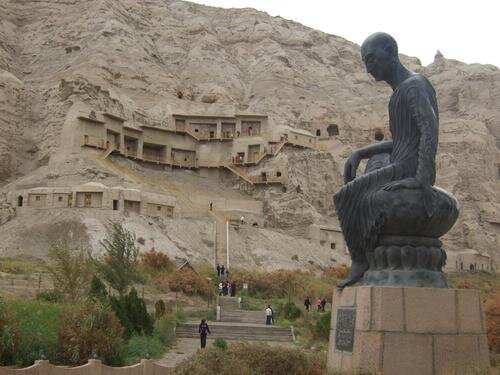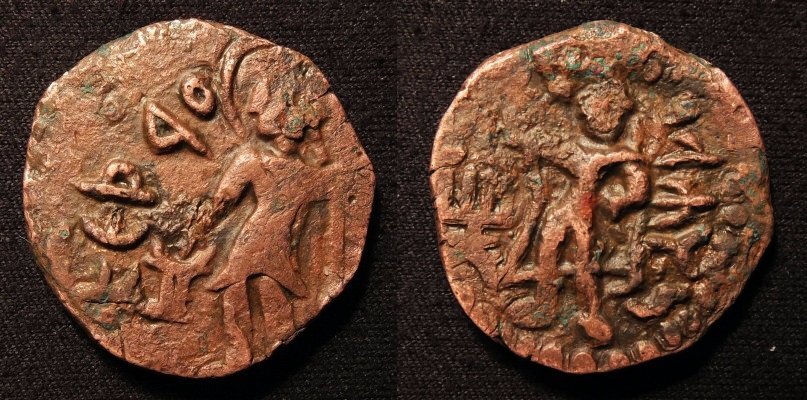Ep. 247 | The History of Xinjiang (Part 4)
In this episode, we bid farewell to the Han Dynasty and hello to a long period of a disunited China. The states and kingdoms of the basins of Xinjiang catch a bit of a break. We also take a quick look at a few of the kingdoms of the southern Tarim Basin as well as Turpan.
And what episode would be complete without some nomadic bad guys causing the Chinese so much stress? We also look at the Rouran and the Hephthalites.
Listen On Your Favorite Podcast Player
Terms in Episode
| Pinyin/Term | Chinese | English/Meaning |
|---|---|---|
| Bān Yǒng | 班勇 | Youngest Son of Ban Chao |
| Charklik (Kǎ kè lǐ kè) | 卡克里克 | Ancient city near present day Ruòqiāng |
| Cherchen (Qiěmò) | 且末 | City and county west of Loulan. Also known as Cherchen, Charchan and Qarqan. Located in southern Xinjiang |
| Cáo Cāo | 曹操 | c. 155-220, Chinese military great and respected man of letters. Helped put the Han Dynasty out of its misery |
| Cáo Wèi | 曹魏 | The northernmost kingdom during the Three Kingdoms period. It ran from 220-266 CE. Founded by Cao Pi, son of Cao Cao |
| Cǎoyuán Sīchóu Zhī Lù | 草原丝绸之路 | The Grassland Silk Road |
| Dūnhuáng | 敦煌 | City in western Gansu famous for the Mogao Grottos and the treasures carted away by Air Aurel Stein and others |
| Dǒng Zhuó | 董卓 | Tyrannical warlord who seized power towards the end of the Eastern Han from 189 to 192. |
| Fù Jièzǐ | 傅介子 | Chinese military man who led the secret mission to go teach the king of Loulan a lesson |
| Gānsù | 甘肃 | Province of Western China. Capital is Lanzhou |
| Gāochāng | 高昌 | Also called Karakhoja, the "Chinese colony" setup where the Jushi Kingdom used to be. Later the site of a Chinese Commandery (郡) |
| Gūshī | 姑师 | Another name of Jushi |
| Gūshī Wénhuà | 姑师文化 | The Culture of Ancient Gushi, the earliest residents of Turpan |
| Hàn Dynasty | 汉朝 | The Chinese dynasty founded by Liu Bang. Ran from 206 BCE to 220 CE |
| Hétián | 和田 | The Chinese name of Khotan |
| Héxī Corridor | 河西走廊 | Also known as the Gansu Corridor, the main road from westernmost China to the easternmost Tarim Basin where the northern route of the Silk Road began |
| Hāmì | 哈密 | One of Xinjiang's most famous places, located in the Turpan Basin, an ancient civilization and darn good melons. Go try one. |
| Jīngjué | 精绝 | Niya was referred to as the Jingjue in the Book of Han |
| Jūshī Kingdom | 車師 | Located in present day Turpan, once a great and ancient kingdom. Also known as Gūshī 姑師. Will be discussed next episode |
| Kashgar | 喀什 | City in China in the extreme far west of Xinjiang with a rich and fabled history. Also known as the Kingdom of ancient Shule |
| Khotan | 和田 | The Kingdom of Khotan, now the city of Hetian in southern Xinjiang |
| Kingdom of Shǔ | 蜀国 | Also known as Shu Han, the kingdom led by Liu Bei, located in and around Sichuan. It ran from 221-263 CE |
| Kucha | 库车 | Located in modern day Qiuci in Xinjiang. Site of one of the most glorious kingdoms in the Tarim Basin |
| Kāshí | 喀什 | The Chinese name of Kashgar |
| Kūnlún Mountains | 昆仑山 | Mountain chain separating the Tibetan Plateau with the Tarim Basin |
| Liu Bang | 刘邦 | 256-195 BCE, founder of the Han Dynasty. Temple name was Han Gaozu |
| Liáng Dynasty | 前凉 / 后凉 | There are many Liang Dynasties. The one we're talking about here are the Former and Later Liang that ran 320 to 403 |
| Liú Bèi | 刘备 | 161-223, Emperor of Shu Han (see above) |
| Lop Nor / Luóbù Pō | 罗布泊 | Ancient salt lake, now mostly dried up where two of Xinjang's greatest rivers flowed into. Lop Nor once covered 10,000 square km of area |
| Lóulán | 楼兰 | Known also as Krorän, an ancient kingdom on the north shores of Lop Nor. Loulan was later renamed Shanshan after China took it over |
| Méng Tián | 蒙恬 | Died in 210 BCE, Qin Dynasty general, inventor and a loyal soldier of Qin Shihuang |
| Mòdú Chányú | 魔都禅语 | 234-174 BCE, the founder of the Xiongnu Empire |
| Northern Wèi | 北魏 | 386-534, also known as the Tuoba Wei because of the founding Tuoba Clan. |
| Níyǎ | 尼雅 | Far western part of the Shanshan Kingdom |
| Níyǎ Yízhì | 尼雅遗址 | The Níyǎ Ruins, a well-plundered site whose relics can be seen in India, Japan and Britain |
| Qiūcí | 龟兹 | City in Xinjiang where the Kingdom of Kucha was located |
| Róurán | 柔然 | A Donghu 东胡) Xianbei 鲜卑) tribal confederation whose Khaganate lasted from 330 to 555 CE |
| Rǔanrǔan | 蠕蠕 | One of the several other names of which the Rouran are known. |
| Shànshàn | 鄯善 | The former Kingdom of Loulan, renamed Shanshan after Fu Jiezi did his thing |
| Shūlè | 疏勒 | The Chinese name of the Kingdom of Kashgar |
| Shǎnxī | 陕西 | Province in northwest China famous for a million things, including being next to a province that sounds almost the same |
| Suí | 隋朝 | The Sui Dynasty 581-618 |
| Sāi | 赛 | Ancient Indo-Iranian people who settled in southern Xinjiang and other places in Central Asia. Known as the Saka (and other names) |
| Sūbèixī Wénhuà | 苏贝希文化 | Sūbèixī Culture, sanother nsame for the Gushi Culture.\ |
| Tiānshān | 天山 | The Heavenly Mountains, located north of the Tarim Basin |
| Tǔlǔfān | 吐魯番 | The city of Turpan or Turfan depending on how you feel |
| Wú Kingdom | 吴国 | Also known as Sun Wu 孙吴 or Eastern Wu 东吴. The kingdom run by Sun Quan 孙权. It lasted 222-280 |
| Wǔhú | 五胡 | "The Five Barbarians", name applied to northern steppe nomads who stressed out China from time immemorial |
| Xinjiang | 新疆 | The area that is now contained in the Xinjiang Uyghur Autonomous Region in China. Also known by many names prior to 1884 |
| Xiānbēi | 鲜卑 | A nomadic people from the Mongolian Steppe thought to have come from the Donghu 东胡 People |
| Xiōngnú | 匈奴 | A once powerful confederation of tribes whose empire once stretched from the eastern reaches of the Mongol homeland and into East Central Asia |
| Xiǎohé | 小河 | Also known as the Ördek Necropolis, an ancient site not far from Lop Nor that contained a great number of Tarim Mummies |
| Xuánzàng | 玄奘 | 602-664. Seventh century Buddhist pilgrim and adventurer who traveled to India and back |
| Yuèzhī | 月氏 | A nomadic people originally based in and around Gansu Province |
| Yàndā | 囐哒 | The Chinese name given to the Hepthalites (or White Huns) |
| Yánghǎi Gǔmù | 楊海古墓 | Yánghǎi Tombs. Another necropolis that yielded many Tarim Mummies |
| Yùjiǔlǘ Shèlún | 郁久闾社仑 | Founding Khagan of the Róurán from 402 to 410 |
| Yútián | 于田 / 于阗 | Ancient Chinese name for Khotan (Hetian) |
| Zhāng Qiān | 张骞 | The great Han adventurer who journeyed to the West between 138-126 BCE and whose story is immortalized in ancient Chinese texts |
| Zhūgé Liàng | 诸葛亮 | 181-234, Great military and political strategist, chancellor and inventor |























In this arguable milestone episode, we finally get around to the Uyghurs, discuss their ancient history and examine how they rose from one of several tribes in a Turkic confederation to their own Khaganate.